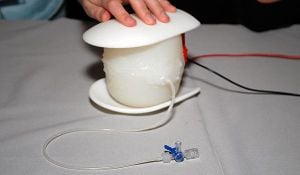
Problem being addressed[edit | edit source]
Uterine atony, a loss of uterine muscle tone after cesarean birth, affects more than three million women each year. It can lead to potentially fatal postpartum hemorrhage, and treatment in low-resource clinical setting is often inadequate.
Detailed description of the solution[edit | edit source]
The Mechanical Uterine Clamp applies three different levels of compression to the uterus after a cesarean section. This device is simple to use and an inexpensive alternative to uterine massage.
Designed by[edit | edit source]
- Designed by: This device was designed by a team of five engineering students at the University of Virginia through a course offered by Timothy Allen, an Assistant Professor of Biomedical Engineering. These students are: Kimberly Everett, Vinu Ilakkuvan, Lara Wooten, Katie Youell and Kathryn Barbante. PDF available here.
- Manufacturer location: The University of Virginia, USA
Funding Source[edit | edit source]
This project received funds ($16,100) from the National Collegiate Inventors and Innovators Alliance in 2008. Link available here.
References[edit | edit source]
Other internally generated reports[edit | edit source]
University of Virginia School of Engineering and Applied Science. (2009, Spring). Reducing the risk of caesareans. Retrieved January 6, 2013. PDF available here.
Externally generated reports[edit | edit source]
National Collegiate Inventors and Innovators Alliance. (2008). Uterine atony device design team. Retrieved January 6, 2013. Link available here.